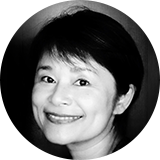First, the atomic bombing of Hiroshima on the 6th. Then, the bombing of Nagasaki on the 9th. Finally, the 15th is the day Japan surrendered to the Allies to end World War II. There are memorial ceremonies for the victims of the bombings and the War, all of which are broadcast on national television. It makes for a somber atmosphere. By pure coincidence, mid-August is a period called Bon, which lasts a few days. It’s rooted in a Buddhist tradition where the souls of ancestors come back to household altars. People return to ancestral homes, visit family graves, gather for meals, and talk about the deceased. Houses are decorated with colorful lanterns and ornaments made from summer vegetables like cucumbers and eggplants so that the souls of ancestors can find their way home as they descend from heaven. Incense fills the air.
August is associated with death, which was difficult for me to comprehend as a child. I understood it’s not something I should feel joyful about. I remember being afraid, imagining the souls of the dead floating around me while lying on a futon in the dark.
One summer though, I went back to my mother’s ancestral town. It was the first Bon after my grandfather passed away. Rituals differ by region. Our town is on the coast and at the end of Bon every household creates a miniature wooden boat to carry the souls of the dead back to heaven. The first Bon tends to be difficult because the death is still raw, the memories fresh. And this is the same for the dead too, who are leaving their beloved homes after their first visit. So the miniature boat is beautifully decorated to make the soul feel better and not so lonely. The boat is released by family members out into the pitch-dark ocean at night. I remember my mother and some other women crying, saying goodbye to my grandfather. But then I looked up and saw what was happening around us. Many other boats were floating on the waves. Brightly lit lanterns were everywhere, making the dark water look like the sky filled with stars. At that moment, I realized the meaning of holding this ritual with the whole community. It helps you realize you aren’t the only one grieving for the loss of a loved one. Many others are also going through difficult times. The scene consoled me. We can cry together, heal together, and move forward together. I haven't dreaded the arrival of August since that summer.
I’ve become an adult, and as a journalist I cover these anniversaries and talk about the legacy of the War. In 2018, 73 years after WWII, I went to Hiroshima for the ceremony at the Peace Memorial Park.

I met a 92-year-old woman who was writing down the names of her family members to be put on lanterns. Later in the evening, the lanterns would be released on the Motoyasu River, which on that fateful day was the horrific scene of a mass of burned victims. She told me the atomic bomb killed her mother, father, and sister. “They all vomited blood a few days after the bombing and died," she said. "The A-bomb is the scariest thing.”

Another man carried a Senbazuru, one thousand paper cranes on string. These are placed on glass cases behind a statue commemorating Sadako Sasaki. Sadako was among the victims who developed leukemia from radiation exposure. While in hospital, she folded over one thousand paper cranes, hoping it would grant her the wish of recovery. But she died at the age 12. Her story is now famous and visitors bring their own Senbazuru to the statue. This man said his father, a survivor himself, made these cranes. The city of Hiroshima receives about ten tons of paper cranes every year, which are recycled. Some are used to make the paper lanterns.

By 7PM, the lanterns started being released out onto the river. Their light filled the dark water, just like the stars in the sky, carrying wishes for peace. Some survivors were there, but many were too young to have memories of the War. The sight of the floating lanterns makes one realize you are not the only one grieving or crying or feeling helpless. The atmosphere was probably similar in Nagasaki, as thousands watched white doves being released in the air at the memorial ceremony. Antonio Guterres was there, becoming the first Secretary General of the United Nations to attend the Nagasaki anniversary. “No more Hiroshima, No more Nagasaki, No more Hibakusha," he said.

“We shouldn’t forget what enormous damage one atomic bomb can inflict”, said a French visitor who brought his daughter to witness the anniversary. The lesson of August is also something we should not forget. The series of events that led to the War, the inhumanness of it all, and how it ended. We should remember this so history does not repeat itself.

